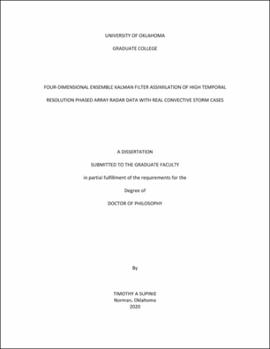| dc.contributor.advisor | Xue, Ming | |
| dc.contributor.author | Supinie, Timothy | |
| dc.date.accessioned | 2020-05-08T20:46:25Z | |
| dc.date.available | 2020-05-08T20:46:25Z | |
| dc.date.issued | 2020-05 | |
| dc.identifier.uri | https://hdl.handle.net/11244/324342 | |
| dc.description.abstract | With the US National Weather Service (NWS) Weather Surveillance Radar-1988 Doppler (WSR-88D) radar network aging, a candidate for replacing it is phased array radar (PAR). The defining feature of PAR is an electronically steered beam, which allows for much faster volumetric updates than the mechanically steered beam from the WSR-88Ds. The higher temporal resolution afforded by PAR could be useful for initializing convective-scale numerical forecasts for purposes of issuing warnings based on forecasts of severe convective hazards, rather than on detection. The purpose of this work is to evaluate the performance of PAR versus the current operational WSR-88Ds in this context. Data collected during two supercell severe weather events in central Oklahoma are used in two sets of ensemble data assimilation (DA) and forecast experiments.
The first case is the 22 May 2011 Ada, Oklahoma supercell. These experiments use 40 ensemble members at 2 km grid spacing and a 4-dimensional ensemble square root filter (4D EnSRF). The Advanced Regional Prediction System (ARPS) is used for the forecast model. The WSR-88D elevations are grouped into 1-minute batches to compare to the 1-minute PAR volumes. For this case, after 30 minutes of DA, the experiment using PAR data outperformed the experiment with WSR-88D data in the placement and rough intensity of the mesocyclone track and using several objective performance metrics, such as equitable threat score (ETS) and area under the relative operator characteristic (ROC) curve (AUC). After 45 minutes of DA, the advantage of PAR over the WSR-88D is reduced, suggesting that PAR data are most beneficial when the DA period must be short, perhaps to quickly spin up a storm in the ensemble. This would afford a longer lead time for a severe weather warning. A supplemental experiment using PAR data thinned in elevation angles to imitate the WSR-88D data batches confirms that the advantage is due to the extra data volumes provided by the PAR.
The second case is the 31 May 2013 El Reno, Oklahoma supercell. The data processing for the WSR-88D and 1-minute PAR data is nearly identical to the 21 May 2011 case. For these experiments, the 4D EnSRF is used with the Weather Resesarch and Forecasting (WRF) forecast model. 36 members at 1 km grid spacing are used. In this case, the PAR experiment results in stronger mesocyclones because of a stronger mid-level temperature perturbation. Examination of the analysis increments by PAR volume reveals that in the default experiment, only the first 3 PAR volumes provide significant changes to the ensemble state. This is because the reflectivity innovation is reduced by having updated previous volumes, and an experiment with additional covariance inflation between PAR volumes is run that confirms this. In order to alleviate this, experiments are conducted assimilating the radar volumes in different orders, such as reversed, starting from the analysis time and working towards the edges of the DA window (“inside out”) and the reverse of that (“outside in”). The results suggest that the different orders can improve track forecasts due to warmer temperatures in the analyzed cold pool near the mesocyclone. Additionally, colder forecast cold pools were found to be due to drier analyses in the near-storm inflow. The colder forecast cold pools also contributed to track displacement errors. | en_US |
| dc.language | en_US | en_US |
| dc.rights | Attribution-ShareAlike 4.0 International | * |
| dc.rights.uri | https://creativecommons.org/licenses/by-sa/4.0/ | * |
| dc.subject | Data Assimilation | en_US |
| dc.subject | Phased Array Radar | en_US |
| dc.subject | Numerical Weather Prediction | en_US |
| dc.title | FOUR-DIMENSIONAL ENSEMBLE KALMAN FILTER ASSIMILATION OF HIGH TEMPORAL RESOLUTION PHASED ARRAY RADAR DATA WITH REAL CONVECTIVE STORM CASES | en_US |
| dc.contributor.committeeMember | Jung, Youngsun | |
| dc.contributor.committeeMember | Shapiro, Alan | |
| dc.contributor.committeeMember | Zhang, Guifu | |
| dc.contributor.committeeMember | Zhang, Yan | |
| dc.date.manuscript | 2020-05 | |
| dc.thesis.degree | Ph.D. | en_US |
| ou.group | College of Atmospheric and Geographic Sciences::School of Meteorology | en_US |

